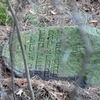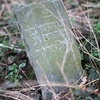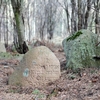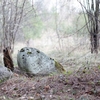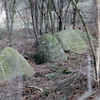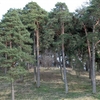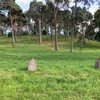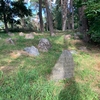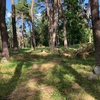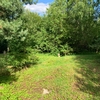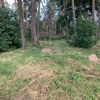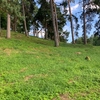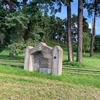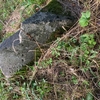EN:
The Jewish Cemetery of Anykščiai
Anykščiai was first mentioned in documents from the 15th century, and a Jewish community is recorded in the town as early as the beginning of the 17th century. From the second half of the 19th century, the town became an important center of Jewish life – trade and crafts flourished, and there were workshops producing various goods. Although the town was repeatedly ravaged by fires, the Jewish community continually rebuilt itself – establishing prayer houses, schools, and communal organizations.
The Jewish cemetery is located on a high, undulating hill covered with pine trees. The area is enclosed by a fence made of concrete posts, though the spaces between the posts are not connected. Jews from Anykščiai were buried here from the late 17th century until the first half of the 20th century.
Granite tombstones with Hebrew inscriptions have survived in the cemetery. Most are concentrated in the central area, but throughout the territory there are also toppled, broken, and sunken tombstones or their fragments.
In 2023–2024, the Jewish cemetery in Anykščiai was documented by Maceva volunteers. In addition to the regular volunteers – Inga, Živilė, Irina, and Jolanta – students from the Anykščiai Jonas Biliūnas Gymnasium joined the initiative, led by their teacher Jūratė Musteikienė.
Prior to the documentation work, it was estimated that there were about 200 gravestones in the cemetery. However, volunteers recorded 1,065 burial sites. A large portion of the stones are unreadable or bear no inscriptions. The earliest decipherable gravestone is dated to 1804.
The documentation project was funded by descendants of the Jews of Anykščiai and the Good Will Foundation.
Photography by Živilė Tamulionytė, epitaph translations by Avishai Lubitch.
General view photos by K. Sereikaitė (2012) and M. Jakulytė (2022).
LT:
Anykščių žydų kapinės
Anykščiai pirmą kartą paminėti XV a. dokumentuose, o žydų bendruomenė čia minima jau XVII a. pradžioje. Nuo XIX a. antrosios pusės miestelis tapo svarbiu žydų gyvenimo centru – čia klestėjo prekyba ir amatai, veikė įvairios dirbtuvės. Nors miestą ne kartą niokojo gaisrai, žydų bendruomenė vis atgimdavo iš naujo – statė maldos namus, steigė mokyklas ir bendruomenines organizacijas.
Žydų kapinės įrengtos ant aukštos, banguoto reljefo kalvos, apaugusios pušimis. Teritorija aptverta betoninių stulpelių tvora, tačiau tarp jų nėra jungčių. Kapinėse palaidoti Anykščių žydai nuo XVII a. pabaigos iki XX a. pirmosios pusės.
Kapinėse išlikę granitiniai antkapiniai paminklai su hebrajiškais įrašais. Dauguma jų stovi centrinėje dalyje, tačiau teritorijoje taip pat yra nuvirtusių, suskaldytų ar į žemę įsmukusių paminklų bei jų fragmentų.
2023–2024 m. Anykščių žydų kapines dokumentavo asociacijos „Maceva“ savanoriai. Prie nuolatinių komandos narių – Ingos, Živilės, Irinos ir Jolantos – prisijungė Anykščių Jono Biliūno gimnazijos moksleiviai su mokytoja Jūrate Musteikiene.
Iki dokumentavimo darbų buvo manoma, kad kapinėse yra apie 200 paminklų. Tačiau savanoriai suskaičiavo 1065 palaidojimus. Dalis akmenų neįskaitomi arba be užrašų. Ankstyviausias paminklas su perskaitomu tekstu datuojamas 1804 metais.
Projektą finansavo Anykščių žydų palikuonys ir Geros valios fondas.
Kapines fotografavo Živilė Tamulionytė, epitafijas vertė Avishai Lubitch.
Bendro vaizdo nuotraukos – K. Sereikaitės (2012 m.) ir M. Jakulytės (2022 m.).
